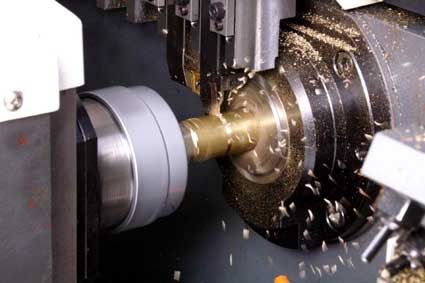How to Set the Cutting Amount When Cutting Stainless Steel?

The amount of cutting has a great influence on the work hardening, cutting force, cutting heat, etc. in the processing of stainless steel, especially on the durability of the tool. Whether the selected cutting amount is reasonable or not will directly affect the cutting effect.
|
Table 4 Cutting amount for turning thread and drilling, expanding and reaming |
|||
| Process name |
Cutting speed Vc (m/min) |
Feed rate f (mm/r) |
Cutting depth ap (mm) |
| Turning thread | 20~50 | - | 0.1~1 |
| drilling | 12~20 | 0.1~0.25 | ≤17.5 |
| Reaming | 8~18 | 0.1~0.4 | 0.1~1 |
| Hinged hole | 2.5~5 | 0.1~0.2 | 0.1~0.2 |
| Note: The tool material is high speed steel | |||
1. Cutting speed Vc:
When machining stainless steel, the cutting speed is slightly increased, the cutting temperature is much higher, the tool wear is increased, and the durability is greatly reduced.
In order to ensure reasonable tool durability, it is necessary to reduce the cutting speed, generally selected from 40% to 60% of normal carbon steel. When boring and cutting, the cutting speed will be reduced due to the tool rigidity, heat dissipation condition, cooling and lubrication effect and chip removal condition are worse than the outer circle of the vehicle.
Different types of stainless steel have different machinability, and the cutting speed needs to be adjusted accordingly. Generally, the austenitic stainless steel such as 1Cr18Ni9Ti has a cutting speed correction coefficient Kv of 1.0 and a hardness of 2cr13 or less of HRC28 or less. The Kv of the martensitic stainless steel is 1.3 to 1.5, and the Kv of the martensitic stainless steel such as 2Cr13 having a hardness of 28 to 35 is 0.9 to 1.1. The Kv of a martensitic stainless steel such as 2Cr13 having a hardness of HRC35 or more is 0.7 to 0.8. The Kv of concentrated nitric acid resistant stainless steel is 0.6 to 0.7.
2. Cutting depth ap:
When roughing, there is a large margin, and a larger cutting depth should be selected to reduce the number of tool-walking, and at the same time avoid contact between the tip and the skin of the blank to reduce tool wear. However, increase the depth of cut should be careful not to cause vibration due to excessive cutting force, optional ap = 2 ~ 5 mm. A smaller cutting depth can be selected for finishing, and the hardened layer should be avoided. Generally, ap=0.2 to 0.5 mm is used.
3. Feed amount f:
The increase in feed rate is not limited by the power of the machine tool. Moreover, the cutting residual height and the chip accumulation height increase with the increase of feed, so the feed can not be too large.
In order to improve the quality of the machined surface, a smaller feed rate should be used for finishing. At the same time, it should be noted that f must not be less than 0.1 mm / r, avoid micro-feed, so as not to cut in the work hardening zone, and should pay attention to the cutting edge not to stay on the cutting surface. The cutting amount of processed stainless steel is shown in Table 4 and Table 5.
| Table 5. Common cutting amount of stainless steel | ||||||||
|
Workpiece diameter range (mm) |
Turning outer circle | Boring | Cutting off | |||||
| Roughing | finishing | |||||||
|
Spindle speed n (m/min) |
Feed rate f (mm/r) |
Feed rate f (m/min) |
Feed rate f (mm/r) |
Feed rate f (m/min) |
Feed rate f (mm/r) |
Feed rate f (m/min) |
Feed rate f (mm/r) |
|
| ≤10 | 1200~955 | 0.19~0.60 | 1200~955 | 0.10~0.20 | 1200~675 | 0.07~0.30 | 1200~955 |
Manual |
| >10~20 | 955~765 | 955~765 | 955~600 | 955~765 | ||||
| >20~40 | 765~480 | 0.27~0.81 | 765~480 | 0.10~0.30 | 765~480 | 0.10~0.50 | 765~600 |
0.10~0.25 |
| >40~60 | 480~380 | 600~380 | 480~380 | 610~480 | ||||
| >60~80 | 380~305 | 480~305 | 380~230 | 180~305 | ||||
| >80~100 | 305~230 | 380~230 | 305~185 | 380~230 |
0.08~0.20 |
|||
| >100~150 | 230~150 | 305~185 | 230~150 | 305~150 | ||||
| >150~200 | 185~120 | 230~150 | 185~120 | 150以下 | ||||
|
Note: 1.Workpiece material: 1Cr18Ni9Ti; 2.Tool material: YG8. 3.The smaller diameter in the table uses a higher spindle speed, and the larger diameter uses a lower speed. 4.When the workpiece material and tool material are different, the spindle speed should be properly corrected according to the specific conditions. |
||||||||





